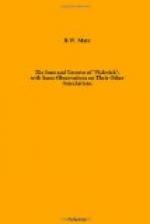It is often mentioned in the Paston Letters in reference to Jack Cade, who made it his headquarters in 1450. In Hall’s Chronicles it is recorded that the Captain, being made aware of the King’s absence, came first to Southwark, and there lodged at the “White Hart.” In Henry VI, Part II, Jack Cade is made to say, “Hath my sword therefore broke through London gates, that you should leave me at the ‘White Hart’ in Southwark?”
Thomas Cromwell, Henry Vlll’s most able minister, was also associated with the borough of Southwark, and on one occasion (in 1529) it is recorded that he received a message to the effect that one R. awaited him at the “White Hart” on important business. Again the inn has mention in connection with the rebellion brought about by Archbishop Laud’s attitude to the Scottish and Puritan Churches, when we are told that the populace and soldiers associated with it lodged at the “White Hart.” And in a like manner mention might be made of other occasions during which, in those far-off days, the “White Hart” played some notable part in history and in the social round of the period.
In 1676 it was entirely destroyed by the great fire of Southwark, but was rebuilt immediately afterward on the old site and on the old model. It was described by Strype about this time as a very large inn, and we believe that it was able to accommodate between one and two hundred guests and their retinue, with ample rooms left for their belongings, horses and goods. It did a considerable trade and was esteemed one of the best inns in Southwark, and so it continued as a favourite place of resort for coaches and carriers until the end of the coaching days.
When, therefore, Mr. Pickwick set all the world agog with his adventures, the “White Hart” was recognized as a typical old English inn, and was really at its best. It had arrived at this prosperous state by easy stages during its previous 180 years, and had a reputation for comfort and generous hospitality during the best days of the coaching era, which had reached the golden age when Mr. Pickwick discovered Sam Weller cleaning boots in its coach yard one historic morning in the early nineteenth century.
It is not to be wondered at, then, that Dickens, who knew this district so well and intimately, should introduce the “White Hart” into his book as a setting for one of his most amusing scenes. After speaking of London’s inns in general, he makes special mention of those in the Borough, where, he says, there still remained some half-dozen old inns, “which have preserved their external features unchanged, and which have escaped alike the rage for public improvement and the encroachments of private speculation.” Since these words were written public improvement has “improved” all of them, except one, the “George,” right out of existence.
But let us use Dickens’s own words to describe these inns in general and the “White Hart” in particular, for none of ours can improve his picture.




